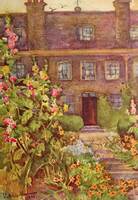Less well known is the delightful Garden of the Greycoat School in Westminster. Most of the old foundations in Westminster have vanished, such as Emanuel Hospital and the "Bluecoat School," which disappeared a few years ago, but so far this charming old house has been respected. Quaint figures of the children in the dress of the time-it was founded by the citizens of Westminster in 1698-stand on either side of the entrance. The children from the parishes of St. Margaret and St. John the Evangelist, who have attended the elementary schools for three years, are eligible for admission, up to the age of ten. The school was reconstituted as a day school for 300 girls in 1873, and, in spite of all educational vicissitudes, has been allowed to survive, and the sweet and wholesome influence of those old-fashioned surroundings would be a great loss, should it ever be swept away. The Garden is delightful. It is practical as well as ornamental, as it furnishes the staff of teachers with a good supply of vegetables. They have each a small flower-bed too, tended with great care, and the children are allowed a place of their own, where they work, dig, and plant. Down the centre runs a wide gravel walk, with a deep herbaceous border along either side, sweet-scented pinks and low-growing plants near the front, then a long row of spiderwort, and behind that a regiment of magnificent hollyhocks. The spiderwort or Tradescantia is a flower eminently suited to London gardens, not only because it seems to withstand any amount of smoke and bad air, but because of its association with the famous garden in Lambeth, where it was first grown. Parkinson, in 1629, gives the history of his friend's introduction of the plant. "The Spiderwort," he writes, "is of late knowledge, and for it the Christian World is indebted unto that painfull industrious searcher, and lover of all nature's varieties, John Tradescant (sometimes belonging to the Right Honourable Lord Robert Earle of Salisbury, Lord Treasurer of England in his time, and unto the Right Honourable the Lord Wotton at Canterbury in Kent, and lastly unto the late Duke of Buckingham), who first received it of a friend, that brought it out of Virginia, thinking it to bee the Silke Grasse that groweth there, and hath imparted hereof, as of many other things, both to me and others." "Unto this plant I confess I first imposed the name... which untill some can finde a more proper, I desire may still continue... John Tradescant's Spider Wort of Virginia." Courageous as herbalists generally were in tasting plants, Parkinson confesses there had "not beene any tryall made of the properties" or "vertues." Luckily no one has disputed Parkinson's choice of a name, and his friend's memory is still preserved. The plant is not confined to Virginia, but grows much further into the Wild West, and is common in Kansas, Nebraska, and distant States. Yet it will still adapt itself to the grimy limits of a London garden, and flower year after year. The Greycoat School Garden is quite refreshing; the plants look so healthy and prosperous that it is really encouraging. The interior of the house, with oak beams and panels, is all in keeping, and the long class-room, with windows looking out on the bright Garden, is most ideal. As, at the close of their afternoon studies, the girls, singing sweetly in parts, join in some familiar hymn, and the melodious sounds are wafted across the sunlit Garden, it is hard to believe in the existence of the crowded, unsavoury slums of Westminster, only a stone's throw from this "haunt of ancient peace."

